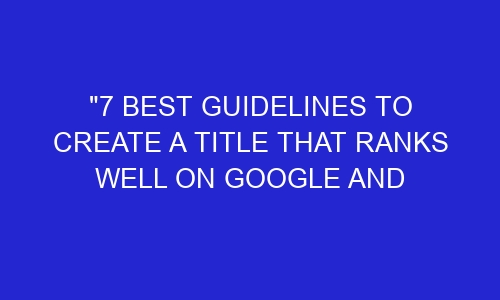Introduction:
Creating a killer title is crucial for any blog post. It needs to grab the reader’s attention, make them interested, and rank well on search engines. But how do we create a title that can achieve all of this? It’s not rocket science, but it does require some thought and a little creativity. Here, we’ll go through seven guidelines that will help you create a title that attracts readers and ranks well on Google.
1. Keep it Short and Sweet:
One of the most critical rules of creating a good title is to keep it short and sweet. A title that’s too long will turn people off, and search engines won’t rank it well either. The ideal title length is around 60 characters. This length gives enough room to convey the main idea or topic of the post and grab the reader’s attention. Examples of short and sweet titles include “5 Easy Tips for Cooking,” “10 Ways to Save Money,” and “7 Secret Tricks to Improve Your Health.”
2. Use Keywords:
Another important guideline to follow is to use relevant keywords in your title. These keywords help search engines understand what your post is about, improving its ranking. Make sure that the keywords you choose are relevant and accurately reflect the content of your post. Don’t try to stuff too many keywords in your title, as this will make it look spammy. For example, if you’re writing about “easy baking recipes,” your title could be “10 Easy Baking Recipes for Beginners.”
3. Be Specific:
Rather than using a generic and broad title that won’t grab anyone’s attention, make your title more specific. This approach will attract the right audience and give a clear idea of what to expect from the post. Specific titles also have a better chance of ranking higher in search engine results. For instance, instead of “10 Delicious Recipes,” use “10 Mouth-Watering Mexican Cuisine Recipes.”
4. Use Adjectives:
Adding adjectives to your title is a great way to make it more appealing. Adjectives give your title an emotional impact and make it more memorable. Choose words that accurately describe what your post is about while being emotive and catchy. For example, instead of “Guide to Saving Money,” use “Ultimate Guide to Saving Money and Living a Rich Life.”
5. Use Numbers:
Including numbers in your title is an effective way to get people’s attention. It makes your title look more organized, provides a sense of structure, and gives a specific idea of what to expect. Odd numbers tend to perform better than even numbers, so try to use odd numbers whenever possible. For instance, “7 Healthy Eating Tips” is more engaging than “6 Healthy Eating Tips.”
6. Use Questions:
Using a question in your title is an excellent way to grab the reader’s attention and generate interest in your post. Questions make readers curious to find out the answer and create a feeling of relevance to their life. To make it more impactful, use “Wh-” questions such as “What,” “How,” “Why,” “When,” “Where.” For example, “What Are the Best Foods to Boost Your Immune System?” or “How Can You Save Money on Your Next Vacation?”
7. Make it Engaging:
Finally, make your title engaging by including power words that evoke an emotional response. Power words create a sense of urgency or excitement and grab the reader’s attention quickly. Examples of power words include “Crazy,” “Insane,” “Mind-Blowing,” “Amazing,” “Secret,” “Proven,” “Simple,” and “Easy.” But be careful not to exaggerate too much, as it could harm your credibility.
FAQs:
Q1. What is the ideal length of a good title?
A1. The ideal length for a title is around 60 characters. Shorter titles are more effective as they grab the reader’s attention quickly and rank well on search engines.
Q2. How do keywords help in improving the ranking of a title?
A2. Keywords help search engines understand what the post is about and improve its ranking. Make sure to choose relevant keywords that accurately reflect the content of your post.
Q3. Why is it important to use specific titles?
A3. Specific titles attract the right audience and give a clear idea of what to expect from the post. This approach helps the post rank higher in search engine results.
Q4. How do adjectives make a title more impactful?
A4. Adjectives make titles more memorable and emotive. They give the title an emotional impact and make it more appealing to readers.
Q5. Why are numbers effective in titles?
A5. Numbers provide a sense of structure and organization to a title. They also give a specific idea of what to expect from the post and make it more engaging.
Q6. How do questions make a title more compelling?
A6. Questions make readers curious to find out the answer and create a feeling of relevance to their life. They also evoke a sense of urgency, making the title more compelling.
Q7. What are some power words that can be used in titles?
A7. Power words create a sense of urgency or excitement and grab the reader’s attention quickly. Examples include “Crazy,” “Insane,” “Mind-Blowing,” “Amazing,” “Secret,” “Proven,” “Simple,” and “Easy.”
Conclusion:
Creating a title that attracts readers and ranks well on Google is all about following these seven guidelines. By keeping it short, using keywords, being specific, including adjectives, using numbers and questions, and making it engaging with power words, you can create titles that will have a greater impact. Ultimately, the goal of any title is to grab the reader’s attention, generate interest in the post, and make them want to read more. So go ahead and be creative with your titles and see how it impacts your blog. And don’t forget the most important part; write excellent content!

